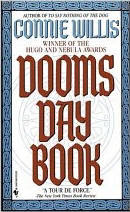 The Oxford University of 2054 has a new way of studying history: first-hand. And the Head of Department’s holiday absence has just given his deputy the chance he’s been waiting for. The Middle Ages risk assessment is downgraded, zero tests are run, and Kivrin Engle, a lone female undergraduate, is about to go back to Christmas 1320. Her tutor Mr Dunworthy is worried sick, especially when he gets a hint that the drop didn’t quite go properly, but soon has little time for thinking of his student: the lab tech collapses before he can say what went wrong, and a jumpy NHS locks the town into quarantine for the duration of the ensuing epidemic. Montoya the archaeologist is desperate to get back to her dig, the visiting American bell ringers are very unhappy about the enforced change of schedule, a colleague’s great-nephew has dodged the barricades, Dunworthy’s secretary is anxious about the rationing of supplies, and William Gaddson’s overbearing mother has come to stay. Basingame is uncontactable, and Gilchrist is being infuriatingly stubborn.
The Oxford University of 2054 has a new way of studying history: first-hand. And the Head of Department’s holiday absence has just given his deputy the chance he’s been waiting for. The Middle Ages risk assessment is downgraded, zero tests are run, and Kivrin Engle, a lone female undergraduate, is about to go back to Christmas 1320. Her tutor Mr Dunworthy is worried sick, especially when he gets a hint that the drop didn’t quite go properly, but soon has little time for thinking of his student: the lab tech collapses before he can say what went wrong, and a jumpy NHS locks the town into quarantine for the duration of the ensuing epidemic. Montoya the archaeologist is desperate to get back to her dig, the visiting American bell ringers are very unhappy about the enforced change of schedule, a colleague’s great-nephew has dodged the barricades, Dunworthy’s secretary is anxious about the rationing of supplies, and William Gaddson’s overbearing mother has come to stay. Basingame is uncontactable, and Gilchrist is being infuriatingly stubborn.
Kivrin thought she had prepared for everything. From languages to manners to horseriding, she had studied everything, and been immunised against every disease Dr Ahrens could think of. But that doesn’t stop something going wrong. Living towns look very different to ancient ruins and names change over time, so she can’t be certain where she is. Nor can she be sure of being able to stay there. And it soon becomes clear that she’s not when she was supposed to be, either. Which means that Oxford might not be able to retrieve her, and she is faced with the prospect of having to make a life for herself in an unfamiliar time - if she can survive.
How tragic am I? If you want to know how I spent Christmas, look no further. I’m not sure of the precise page tally, but it was over five hundred. (I guess it’s nice to see that a small, insular family has one advantage - there was no reason for anyone to object.) Good way to spend the day, though. Kivrin’s portion of the tale - which she jokingly called the Domesday Book - was packed with historical detail; I would love to know enough about a historical period to describe it that well. The dynamics of the family she found shelter with showed that some things never change. But no matter how well she handled the crisis she found herself in, the real hero of the piece was not her but Father Roche. Reviled by the lady of the manor for his illiteracy and superstition but is nevertheless about as close as it comes to a saint.
The twenty-first century thread was even better, a wonderful mix of drama and comedy with a clever and colourful bunch of characters. There were no complicated explanations of how time travel was possible - even the scientists weren’t entirely sure - and the potential problem of changing the past was neatly taken care of. And I had the satisfaction of realising where the epidemic virus had come from before any of the characters did. Unfortunately there was a point where I was jolted out of the book so completely I actually put it down and went in search of a dictionary and encyclopaedia. The epidemic was caused by a virus, but when Badri developed pleurisy the doctor ordered a test and a treatment exclusive to bacteria. The sudden change of microbes had me dashing to see if pleurisy could the result of a secondary bacterial infection, rather than the influenza like I’d initially assumed, but neither book specified, and nor did the novel. My other quibble was the matter of Basingame. It looked like there was a mystery being set up: a lot of time was put into searching for him, no trace was found of him, and as Montoya said, who goes fishing in Scotland in December? Whatever the mystery was, it was never resolved: they never found him!
Rating: A-


No comments:
Post a Comment